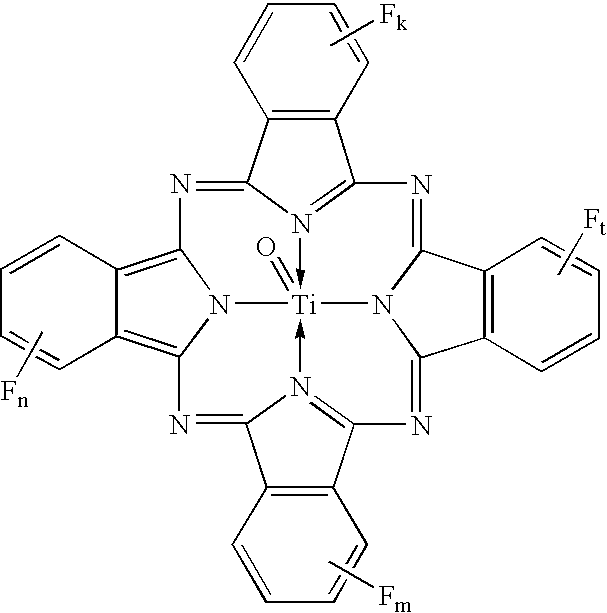Coating solution containing cocrystals and or crystals of a charge-generation pigment or a mixture of charge-generation pigments
a technology of charge-generation pigments and coating solutions, which is applied in the direction of corona discharge, organic dyes, instruments, etc., can solve the problems of low efficiency of the process used for the production of coating solutions containing cocrystals, relatively time-consuming and expensive processes,
- Summary
- Abstract
- Description
- Claims
- Application Information
AI Technical Summary
Problems solved by technology
Method used
Image
Examples
example 1
[0088] One Step Preparation of Dispersion Containing 75:25 Co-Crystalline Mixture of TiOPc and TiOFPc: Polyvinyl Butyral S-lecBM-2 as a Dispersant.
[0089] A 1-gallon-wide mouth glass jar was filled with 9 kgs of 3 mm stainless steel balls, 56.25 grams of TiOPc made from preparation 1, and 18.75 grams TiOFPc made from preparation 2. The jar was put on a roller and roller milled at 85 rpm. The milling was continued for 96 hours, at which time, a small sample was taken and treated in water. That sample was dried and sent for x-ray analysis. The results show that the mixture was fully amorphized. To the bulk of the sample in the jar was added a premixed solution of a polyvinyl butyral S-lecBM-2 (18.75 grams) from Sekisui Chemical Co. LTD of Japan and 1,1,2 trichloroethane (TCE) solvent (1469 grams). The jar was put back on the roller mill and allowed to roll for 72 hours. The beads were then separated from the 1,1,2 TCE pigment dispersion grind. The beads were rinsed with 2 kg of 1,1,2 ...
example 2
[0091] One Step Preparation of Dispersion Containing 75:25 Co-Crystalline Mixture of TiOPc and TiOFPc: DYSPERBYK Dispersant.
[0092] The procedure of Example 1 was used, except that 18.75 grams of the polyester ionomer “SIP”, made from isophthalic acid (95 mole), 4-sodio-isophthalic sulfonate (5 mole %), diethylene glycol (20 mole %), and neopentyl glycol (80 mole %), was used to mill the pigment with 2.25 grams of DYSPERBYK, a polymeric dispersant sold by BYK-Chemie USA. The same letdown procedure was followed.
example 3
[0093] One Step Preparation of Dispersion Containing 75:25 Co-Crystalline Mixture of TiOPc and TiOFPc: Polyvinyl Butyral S-lec BM-2 as a Dispersant.
[0094] The procedure of example 1 was used up to the dry milling step using two jars. Then both jars were emptied into a SZEGVARI attritor type 1SDG, size 1, manufactured by Union Process, of Akron, Ohio. To the attritor 937.5 g of a 1,1,2 trichloroethane S-Lec BM2 solution (4% Solid) were added. The attritor was then run for 6 hours @ 175 RPM. After the 6 hours milling, the mill grind was drained in a bottle. The beads were rinsed with 500 grams of TCE into the mill grind bottle. The mill grind was added to 2818.5 grams of a 4% of the polyester ionomer “SIP” 1,1,2 trichloroethane solution.
PUM
 Login to View More
Login to View More Abstract
Description
Claims
Application Information
 Login to View More
Login to View More - R&D
- Intellectual Property
- Life Sciences
- Materials
- Tech Scout
- Unparalleled Data Quality
- Higher Quality Content
- 60% Fewer Hallucinations
Browse by: Latest US Patents, China's latest patents, Technical Efficacy Thesaurus, Application Domain, Technology Topic, Popular Technical Reports.
© 2025 PatSnap. All rights reserved.Legal|Privacy policy|Modern Slavery Act Transparency Statement|Sitemap|About US| Contact US: help@patsnap.com


